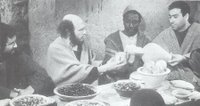In preparation for seeing
Atti Degli Apostoli later this month, I've been (re-)examining some of Rossellini's other films. I've now watched four in the last week, including and having recorded my thought on
Il Messia in last month's
podcast I'd now like to make a few comments about the other three.
Viaggio in Italia - 1953
The first film of the trio was 1953's
Viaggio in Italia starring Ingrid Bergman and George Sanders as an unhappy married couple. The film opens with shots out of their car window. This gives the film a sense of immediacy such that it feels like the film had been playing for some time before we tuned in. Of course in the story of this couple's life, this is exactly what
has happened. As the film settles down, it becomes clear that the marriage is starting to unravel, neither seemingly able to take the steps to bring about the necessary reconciliation.
Finally, after a short time apart (the whole film occurs in less than a week), they agree to get a divorce but are interrupted before the conversation reaches its natural conclusion. In the final scene whilst attempting to escape from the surroundings that have seemingly oppressed them so much during their stay, they are forced to abandon the car in the midst of a crowd. But once in the midst of the throng of people, Bergman is swept away and looks back in desperation towards her husband. He forces his way through to "save" her and the two are reunited and declare their love for each other.
To an audience bred on Hollywood romance, the film's ending feels incredibly abrupt and unrealistic. This has been variously interpreted by some as a deliberately false ending, or as a miracle – particularly as a man is shown directly afterwards carrying a pair of crutches. For my part, I can help but feel that this is part of the film's realism. Couples often argue over the silly little things, and the decision to get a divorce (particularly in 1953) seems facile.
In the same way the moment of reconciliation tuns on similarly insignificant event. Bergman faced no real danger, but it was enough to remind her of her need for her husband, and him of his love for her. Furthermore the moment has enabled them to express things to each other they both needed to share.
 Illibatezza (Chastity) - 1962
Illibatezza (Chastity) - 1962Next up was Rossellini's section from the four way collaboration
RoGoPaG (the other directors being Goddard, Pasolini and Gregoretti. Rossellini's film
Illibatezza (Chastity) is the first of the four and last for about half an hour.
The story revolves around an American business man, Joe, and his obsession with a beautiful yet naïve air stewardess, Anna Maria. We first meet Joe as he looks at a copy of Playboy: that is until he sees Anna Maria when he puts down his magazine to watch her more closely. Clever use of point of view shots and editing mean that the audience quickly find themselves in Joe's place, viewing Anna Maria as an object of desire. He has clearly idealised her innocence which has, in turn, birthed an obsession within him.
Worried about the unwanted attention she is receiving, Anna Maria seeks the advice of her boyfriend. Significantly, we are first introduced to him via a film. Indeed the use of cine cameras throughout the film (Joe, Anna Maria and her boyfriend all use one) indicates that amongst the issues
Illibatezza is raising is the medium of cinema itself. No less important is his absence from her life. Throughout the film's duration the two are never together.
Anna Maria's boyfriend discusses the problem with a psychologist friend of his, whose diagnosis is shocking: Joe is a psychopath with a fixation on Anna Maria's purity. In order to shake him off, she is advised to give the appearance of looseness. She dresses more provocatively and dyes her hair blonde.
Fans of of Hitcock's earlier, although colour, film
Vertigo will notice numerous similarities. The voyeurism and obsession displayed in this film are reminiscent of that film as is the way in which a woman is co-ursed into turning blonde by an emotionally detached boyfriend. The scenario is far less extreme, and the genre is comedy rather than thriller, but thematically the two are very similar.
As predicted, Joe acts with horror and is left only with his memories. Having initially rejected the sexually "available" blonde of his Playboy magazine, in favour of a "virginal" brunette, he finds that she has become the image of the girl in the magazine. In the film's most comical scene Joe projects the film he took of Anna Maria onto the wall of his hotel room and seeks, in vain, to grasp her image. He has once again chosen the pure brunette over the sexually "active" blonde only this time he has chosen an image of a woman over the real thing. Joe's fruitless grapsing is both comic and tragic. He is left only with his obsession, unable to lay hold of a relationship with a real person.
Interestingly, Joe's revulsion at Anna Maria's new look is matched by that of her boyfriend. Even though she is clearly uncomfortable with her new image, Joe turns away in disgust upon seeing it. Like Scotty in
Vertigo he has re-fashioned the appearance of his girlfriend only to be appalled by what he sees. In trying to protect her he has caused a rift in their relationship.
Roma Città Aperta (Rome, Open City) - 1945
This was Rossellini's breakthrough film and it was my second viewing. Whilst remembering only few images from the film prior to rewatching it (Pina's death and Don Pietro's interrogation in particular), I was astounded at how familiar the images were once I saw them again.
One thing I don't remember appreciating the first time around is the film's humour, particularly in the earlier scenes. This is not uncommon for Rossellini. Both of the previous two films involve some form of humour, and
Il Messia occasionally injects irony into the proceedings.
I was also surprised at how graphic the torture scene was at the end. Sadly the person I watched it with found it all a bit much, and this detracted from me enjoying the film's climax as much as I did the first time I watched it.
As the film that popularised neo-realism it's hard to appreciate it's innovations over 60 years later. That said, knowing that this film was shot in the places where the original events occurred gave the film a real edge this time around. Similarly, the acting of Don Pietro in particular is strengthened by the expressiveness of his normal face.
I also noticed how the film blurs the line between the heroes and the villains by inserting two characters into the film who lie somewhere between the Nazi's and the Italian resistance. In the first half of the film (up to Pina's death – the sudden, unexpected nature of which causing a significant shift in the film's tone) there is an Italian policeman who is both friendly with those on his beat and who helps them during the Nazi raid on the neighbourhood. The second, darker, part of the film features a singer who has betrayed Don Petrino and his companions in order to get a fix.
What is interesting is that we sympathise with the policeman, even thought he works overtly for the enemy, whereas the singer's betrayal elicits the opposite response. However there is a twist right at the end when the cocktail of drugs and drink she bought with her information leave her unconscious on the floor. Her female confidant (and, it is implied, her lover) bends over only to reclaim the coat which she had supposedly given her. The singer remains on the floor only now our perception of her has become more sympathetic.
Labels: Atti Degli Apostoli, Il Messia, Other Films, RoGoPaG, Rossellini



















































